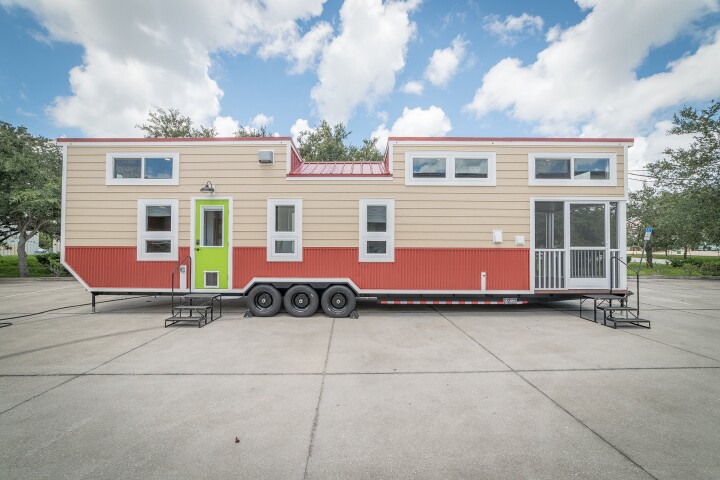Axiom Holographics has opened a unique family attraction in Brisbane, Australia, a kind of augmented reality zoo built around a much larger version of Euclideon's multi-viewpoint 3D display tables and Unlimited Detail graphics engine.
We've written about this fascinating tech before. Yes, you need glasses and screens and a darkish room, but no, it's not like a 3D movie. Essentially, the glasses are position-tracked, and a graphics engine generates a different image for every eye that's looking at the screens, to render whatever's happening from that eye's unique perspective.
All of these perspectives are mashed into a single image projection – it looks like static on an ancient TV to the naked eye – but each lens is a crystal frequency separator that filters out everything but the image created especially for that eye.
That means you have a 3D image that appears to float in the air, that stays in place if you move your head or even walk around it, and that multiple people can view at once from different perspectives. Yes, you can deliver a similar experience with virtual or augmented reality headsets, but they're big and heavy on your noggin, and these aren't, so they feel less isolating and more social.

It works very well – I've seen it in person, back when Euclideon was focused on holographic arcade games, featuring 3D game sprites floating in the air above diagonal screens built into large arcade machines.
Much like augmented reality, it's impossible to photograph, so all of the images shown here are faked up. But in my experience, it's a pretty honest representation of what you're seeing when you pop the glasses on – other than the blue tint and glow, which the company says it adds to its promo images so they look more like the Star Wars holograms people seem to expect. Go figure.

Axiom Holographics, formerly Euclideon Holographics, is now using the tech at a larger room scale. The 1,500-sq-m (16,000-sq-ft) "holographic zoo" includes two 20-m (65-ft)-long "tunnels" with screens all along three of the walls, and some 5 m (16-ft) smaller rooms with screens on all four walls. Curiously, not the roof, which would allow for near-total capture of your visual field.
Axiom has cranked out 25 different tunnel experiences, from African safaris to Arctic journeys to prehistoric landscapes full of dinosaurs and undersea environments, as well as nine different options for the smaller rooms, including escape room-type situations featuring lesser-known zoo animals like Dracula and Frankenstein.
It's also built in some 4D-type effects, including chilly arctic breezes and even some animal smells, which I typically have to bring along with me. Being as how they're completely computer-generated, Axiom is happy to play with scale here, making some small creatures much bigger for a unique perspective on them.
There's also a hologram bridge – effectively a bridge over a large screen designed to make you feel like you're walking over a 50-m (164-ft) drop into a canyon, or whatever else the programmers can dream up.

Beyond that, there's some 11 different four-player holographic arcade games, inside another 5-m room, and some silk-screen, 2PAC-style projections in the restaurant area so folk can get their glasses off. Axiom prides itself on super-quick content generation, and says it's been cranking out new experiences regularly.
One key disadvantage when it comes to doing multi-user experiences this way is that the displays can only handle so many different images at once. With each person needing a separate image for each eye, you're limited to five people at a time in the rooms and tunnels, so it becomes a time-limited 15-minute experience in each and about 90 minutes all up.
"Hologram entertainment centers are a fantastic way to be teleported to places that you could not normally visit, and you can experience things you would normally never see," says Axiom CEO Bruce Dell in a press release. "For example, I do not think people really know just how big a whale is, but when they see a giant life-sized whale swim past them at hologram zoo, they all seem to pause in reverent silence because it is something that they would normally never get the opportunity to see in real life. Our first Hologram Zoo is a test site to perfect the technology, we will then be opening hologram entertainment centers all over the world."
The hologram zoo will be open in Brisbane for another six months, after which the company says it'll be "ready to open centers in Japan, Texas and Europe," and looking to expand from there.
Check out a video below.
Sources: Hologram Zoo/Axiom Holographics












